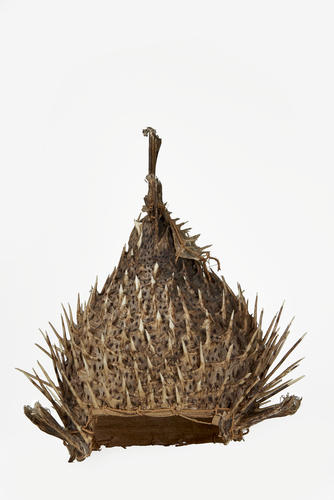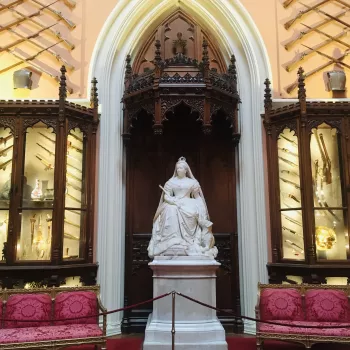Porcupine fish helmet (te barantauti) c.1950-1959
Porcupine fish skin | 37.0 x 28.0 x 20.0 cm (whole object) | RCIN 74039

Gilbert and Ellice Islands
Porcupine fish helmet (te barantauti) c.1950-1959
-
A helmet (te barantauti) made from the dried skin of a porcupine fish, the tail uppermost and with the fins as ear pieces. The inside lined with coconut fibre or pandanus leaf.
When alarmed, porcupine fishes inflate their bodies dramatically as a form of defence. If killed in this state, the skin retains its distended shape and can be dried before being gutted and lined for wear. Such helmets were traditionally worn by warriors in the Gilbert Islands (now Kiribati) and might be accompanied by body armour made from coconut fibre. They were probably too fragile to protect the wearer against a direct blow to the head and therefore seem to have been designed primarily to show status and intimidate the enemy.
Production of such armour had virtually ceased by the mid-twentieth century thanks to the pacifying efforts of British colonial officials and missionaries, which meant ritual combat was no longer required as a means of resolving conflict over land. This piece is therefore likely to have been made specifically for The Duke of Edinburgh's visit, possibly by the last known maker of such armour, Tebeioo, who worked on the island of Beru. If so, it may be the first helmet of this kind to have been made for a period of over 50 years (see Fighting Fibres, ed. Julie Adams, Polly Bence and Alison Clark, p.43).Provenance
Presented to Prince Philip, Duke of Edinburgh at Tarawa by the Island Communities of Beru Island during his visit to the Gilbert and Ellice Islands, 25 March 1959
-
Creator(s)
(nationality)Acquirer(s)
-
Medium and techniques
Porcupine fish skin
Measurements
37.0 x 28.0 x 20.0 cm (whole object)
376 g (Weight) (whole object)
34.7 x 31.0 x 21.2 cm (whole object)
Category








